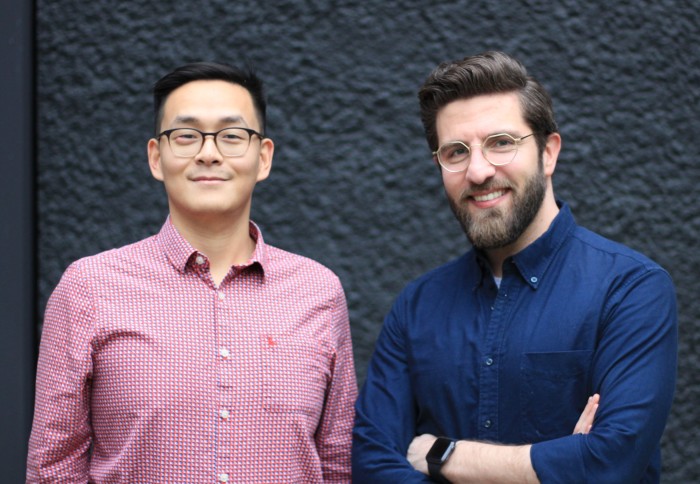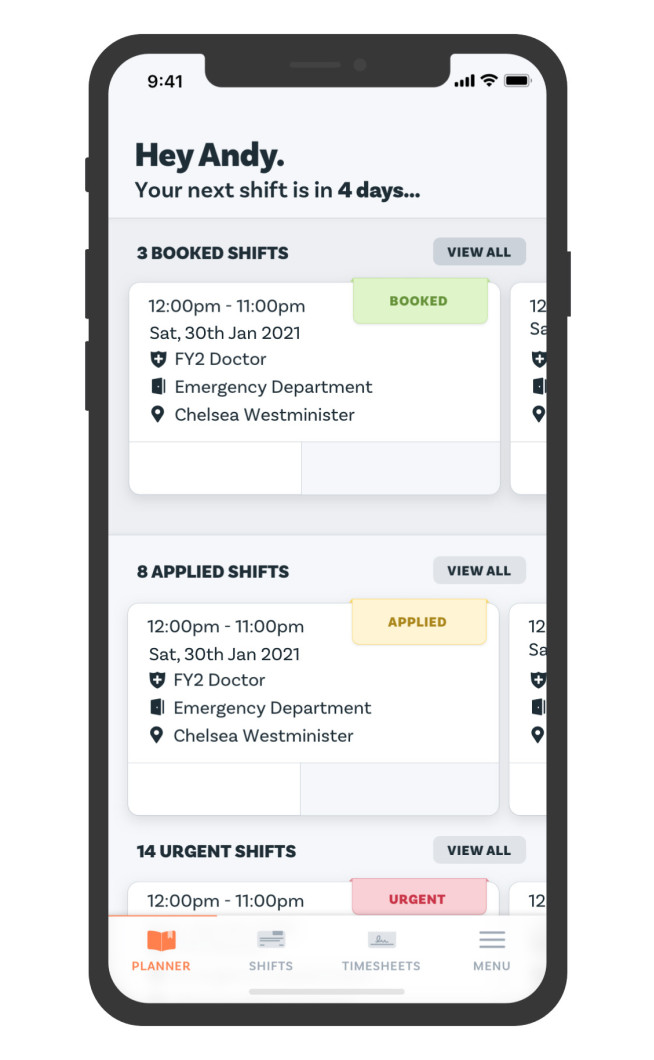When an idea finds you: the story of Patchwork

Imperial graduates and Patchwork founders Dr Jing Ouyang (left) and Dr Anas Nader
Dr Anas Nader and Dr Jing Ouyang are the founders of Patchwork, a workforce management platform for the health and care sector.
They met while studying medicine at Imperial and the two friends both knew from the start that they would end up working together one day.
Anas and Jing were on different pathways at Imperial – Anas was on the graduate entry programme and Jing transferred from Oxford. But fortunately, they had one year of the course where they overlapped. Ever since they first met at Imperial, they knew that they’d make a great team.
Anas: “Jing and I have always known we’d probably do something together at some point. We dabbled with a few other projects, such as Project Pal, which brought clinicians together with people who had innovative ideas.”
We explored a lot of different things before we ended up founding Patchwork. We did various projects together – and you learn a lot from that even if they’re not viable. Dr Jing Ouyang (MBBS 2015)
Jing: “When we left medical school to become doctors, we were still doing things a bit outside of the usual. Those experiences really set us up for starting our own business.”
Anas graduated in 2014 and Jing graduated in 2015. But that didn’t stop the two coursemates from dreaming about new ideas:
Jing: “We kept in touch as friends and colleagues. When we graduated, we moved to different parts of the country – I moved to Liverpool and Anas went to Kent.
“I organised an additional health conference in London and invited some interesting people, including Anas. We got talking, and one of the things that cropped up was temporary staffing. Despite us being on opposite sides of the country, we both had the same challenges – we found it hard to find shifts and get paid on time.”
That conversation was the trigger for what would later become Patchwork. But, being recent graduates with no experience of building enterprise software or managing large projects, they didn’t jump at the opportunity straight away.
Waiting for the right time and place
Anas: “We both wanted to work on a project, but we didn’t immediately see Patchwork as the answer. We wanted something like it to exist to allow us to work flexibly part-time on day shifts so we could pursue something else.
“Then we realised no one is doing anything like that, making it easy for NHS workers to have a portfolio career. But as doctors with no experience of entrepreneurship, we shelved the idea, thinking we’re not ready for it yet.”
Existing technology underestimated the challenge of building enterprise software in the NHS. The Silicon Valley ‘build and they will come’ approach won’t work. There needs to be lots of investment in change management and enabling good workflows. Dr Anas Nader (MBBS 2014)
Not long after Jing’s conference, Anas took a fellowship in Chelsea and Westminster Hospital for a transformation project. He was tasked with looking at the medical agency spend – being exposed to the world of temporary staffing from the employer’s point of view, not just from the worker’s perspective. He realised that many of the managers shared the same vision he and Jing had – a borderless world where doctors could walk in and pick up shifts.
Anas’s experience at Chelsea and Westminster was vital to understanding how to successfully implement technology in a large hospital setting.
While Anas was getting vital experience with change management in the NHS, Jing was developing an itch for creating an innovative startup. Between his two foundation years, he spent a year in Silicon Valley. Then, after returning to the UK, he worked a number of tech roles such as digital health lead at Alder Hey Children’s Hospital.
The ideal testing ground
The two friends knew that there would never be a better time to launch their idea. Anas had been asked by Chelsea and Westminster Hospital to grow their medical bank with a pool of flexible workers and reduce the reliance on expensive agencies. He went to the Chief Operating Officer, Rob Hodgkiss, and explained that to have any meaningful impact on a large scale, better technology was the only answer.

Anas and Jing reached an agreement with the hospital – they would build the software and the hospital would help by testing it.
Anas: “I had a safe environment to learn on the job, and to understand what it takes to build a system that works for thousands of doctors and hundreds of managers. We could make small mistakes and recover and learn from them. I would recommend anyone looking to build medical tech to develop an innovation partnership with a hospital. You have a test environment where you can iterate to get it right, and once it’s right, you have a use case to go to market with.”
The results spoke for themselves.
Anas: “We launched in July 2017 and within a few months we had quite an impressive impact. The hospital achieved over 90% fill rate on their bank, from a baseline of 25-30%. Projected annual savings from agency spend would be £1.2m.”
Scaling up
The next step was to raise more money to develop the software into something they could roll out to other hospitals. Unusually for an early-stage tech company, they concentrated on building a strong operational team.
They knew that training clients to implement and use the software was vital. An angel investor supplied the initial funding of £150,000. Then the project saw success after success, with funding from the Harvard Business Angels, the British Medical Journal and two funding rounds led by Praetura.
Anas: “Now we’re in 25 trusts and about 60 hospitals across the country. We’ve grown from working with bank doctors into doctors, nurses, allied health professionals and pharmacists in every staff group. And we’ve grown from just working with hospitals to working with any type of healthcare employer – primary care GPs, telemedicine providers, other independent providers. We’ve managed to scale the product to a solution that manages any type of workforce in healthcare.”
Ready to seize the moment
Since they first came across the idea for Patchwork, the two doctors knew that it was the right project for them. And they believe their medical training at Imperial was essential in preparing them for success.
Jing: “I don’t think there’s a formula with these kinds of things, but there are things you can do as a medical student and as a doctor that increase your probability of something taking off. I wouldn’t have said ten years ago that temporary staffing was something I was passionate about, but it was something we stumbled upon.”
I get asked by a lot of students what is the next problem to solve. But that assumes you should look for the problem. I believe you don’t find the idea, the idea finds you. Anas
Anas: “The best thing you can do is be ready when an idea presents itself to you. That means figuring out what skills you can invest in yourself. For example, you need financial acumen – basic skills such as understanding how a financial projection works. And presentation skills, being able to tell stories you genuinely believe in, to investors and people you want to hire.
“I believe training in medicine prepares you for entrepreneurship if that’s a path you choose. Good communication skills, breaking bad news if necessary and communicating plans. Digesting a lot of information and analysing it to come up with a good bet – you’re always weighing up options and assessing the odds. And be willing to work weekends!”
Going back to their roots
The two founders met at Imperial, and now the university is part of the next chapter of their project. The team is working with Imperial College University Hospitals to co-create a rostering product. Anas and Jing have already come across a lot of senior clinicians who were professors during their time at medical school.
Jing: “We’ve hired some Imperial graduates as well. One of our product managers also studies medicine at Imperial College. And we’ve been hosting current students from other courses for projects and dissertations.”
Besides the new rostering product, there are some other exciting plans for Patchwork. The team want to grow across the NHS – currently they’re in around 12% of hospitals. And they’re looking at clinician passporting to make it easier for staff to move from one provider to another. Patchwork will become a true one-stop shop for workforce management.
Anas: “We try to stay away from selling licenses and instead focus on selling outcomes. Our solution is delivered through technology but ultimately is about achieving better outcomes for the clinician, employer and the patient.”
To read more stories about the lives and achievements of Imperial graduates, visit our Alumni Stories webpages.
Article text (excluding photos or graphics) © Imperial College London.
Photos and graphics subject to third party copyright used with permission or © Imperial College London.
Reporter
Tina Schmechel
Advancement